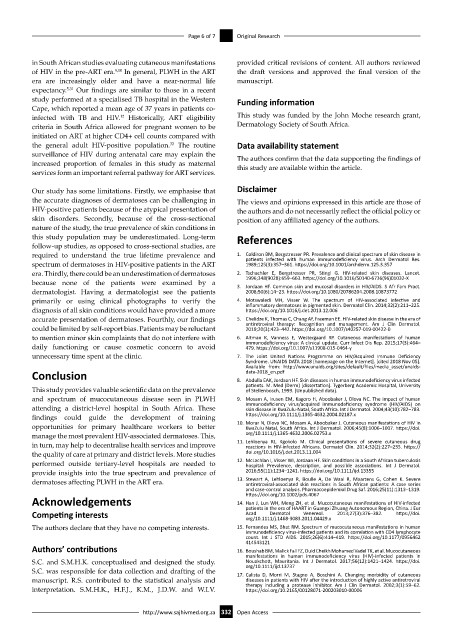Page 340 - HIVMED_v21_i1.indb
P. 340
Page 6 of 7 Original Research
in South African studies evaluating cutaneous manifestations provided critical revisions of content. All authors reviewed
of HIV in the pre-ART era. 9,10 In general, PLWH in the ART the draft versions and approved the final version of the
era are increasingly older and have a near-normal life manuscript.
expectancy. 5,31 Our findings are similar to those in a recent
study performed at a specialised TB hospital in the Western Funding information
Cape, which reported a mean age of 37 years in patients co-
infected with TB and HIV. Historically, ART eligibility This study was funded by the John Moche research grant,
12
criteria in South Africa allowed for pregnant women to be Dermatology Society of South Africa.
initiated on ART at higher CD4+ cell counts compared with
the general adult HIV-positive population. The routine Data availability statement
32
surveillance of HIV during antenatal care may explain the The authors confirm that the data supporting the findings of
increased proportion of females in this study as maternal this study are available within the article.
services form an important referral pathway for ART services.
Our study has some limitations. Firstly, we emphasise that Disclaimer
the accurate diagnoses of dermatoses can be challenging in The views and opinions expressed in this article are those of
HIV-positive patients because of the atypical presentation of the authors and do not necessarily reflect the official policy or
skin disorders. Secondly, because of the cross-sectional position of any affiliated agency of the authors.
nature of the study, the true prevalence of skin conditions in
this study population may be underestimated. Long-term References
follow-up studies, as opposed to cross-sectional studies, are
required to understand the true lifetime prevalence and 1. Coldiron BM, Bergstresser PR. Prevalence and clinical spectrum of skin disease in
patients infected with human immunodeficiency virus. Arch Dermatol Res.
spectrum of dermatoses in HIV-positive patients in the ART 1989;125(3):357–361. https://doi.org/10.1001/archderm.125.3.357
era. Thirdly, there could be an underestimation of dermatoses 2. Tschachler E, Bergstresser PR, Stingl G. HIV-related skin diseases. Lancet.
1996;348(9028):659–663. https://doi.org/10.1016/S0140-6736(96)01032-X
because none of the patients were examined by a 3. Jordaan HF. Common skin and mucosal disorders in HIV/AIDS. S Afr Fam Pract.
dermatologist. Having a dermatologist see the patients 2008;50(6):14–23. https://doi.org/10.1080/20786204.2008.10873772
primarily or using clinical photographs to verify the 4. Motswaledi MH, Visser W. The spectrum of HIV-associated infective and
inflammatory dermatoses in pigmented skin. Dermatol Clin. 2014;32(2):211–225.
diagnosis of all skin conditions would have provided a more https://doi.org/10.1016/j.det.2013.12.006
accurate presentation of dermatoses. Fourthly, our findings 5. Chelidze K, Thomas C, Chang AY, Freeman EE. HIV-related skin disease in the era of
could be limited by self-report bias. Patients may be reluctant antiretroviral therapy: Recognition and management. Am J Clin Dermatol.
2019;20(3):423–442. https://doi.org/10.1007/s40257-019-00422-0
to mention minor skin complaints that do not interfere with 6. Altman K, Vanness E, Westergaard RP. Cutaneous manifestations of human
daily functioning or cause cosmetic concern to avoid immunodeficiency virus: A clinical update. Curr Infect Dis Rep. 2015;17(3):464–
479. https://doi.org/10.1007/s11908-015-0464-y
unnecessary time spent at the clinic. 7. The Joint United Nations Programme on HIV/Acquired Immune Deficiency
Syndrome. UNAIDS DATA 2018 [homepage on the Internet]. [cited 2018 Nov 05].
Available from: http://www.unaids.org/sites/default/files/media_asset/unaids-
Conclusion 8. Abdulla EAK, Jordaan HF. Skin diseases in human immunodeficiency virus infected
data-2018_en.pdf
patients. M. Med (Derm) [dissertation]. Tygerberg Academic Hospital, University
This study provides valuable scientific data on the prevalence of Stellenbosch, 1999. (Unpublished data).
and spectrum of mucocutaneous disease seen in PLWH 9. Mosam A, Irusen EM, Kagoro H, Aboobaker J, Dlova NC. The impact of human
attending a district-level hospital in South Africa. These immunodeficiency virus/acquired immunodeficiency syndrome (HIV/AIDS) on
skin disease in KwaZulu-Natal, South Africa. Int J Dermatol. 2004;43(10):782–783.
findings could guide the development of training https://doi.org/10.1111/j.1365-4632.2004.02187.x
opportunities for primary healthcare workers to better 10. Morar N, Dlova NC, Mosam A, Aboobaker J. Cutaneous manifestations of HIV in
KwaZulu Natal, South Africa. Int J Dermatol. 2006;45(8):1006–1007. https://doi.
manage the most prevalent HIV-associated dermatoses. This, org/10.1111/j.1365-4632.2006.02753.x
in turn, may help to decentralise health services and improve 11. Lehloenya RJ, Kgokolo M. Clinical presentations of severe cutaneous drug
reactions in HIV-infected Africans. Dermatol Clin. 2014;32(2):227–235. https://
the quality of care at primary and district levels. More studies doi.org/10.1016/j.det.2013.11.004
performed outside tertiary-level hospitals are needed to 12. McLachlan I, Visser WI, Jordaan HF. Skin conditions in a South African tuberculosis
hospital: Prevalence, description, and possible associations. Int J Dermatol.
provide insights into the true spectrum and prevalence of 2016;55(11):1234–1241. https://doi.org/10.1111/ijd.13355
dermatoses affecting PLWH in the ART era. 13. Stewart A, Lehloenya R, Boulle A, De Waal R, Maartens G, Cohen K. Severe
antiretroviral-associated skin reactions in South African patients: A case series
and case-control analysis. Pharmacoepidemiol Drug Saf. 2016;25(11):1313–1319.
https://doi.org/10.1002/pds.4067
Acknowledgements 14. Han J, Lun WH, Meng ZH, et al. Mucocutaneous manifestations of HIV-infected
Competing interests patients in the era of HAART in Guangxi Zhuang Autonomous Region, China. J Eur
Acad
Dermatol
https://doi.
2013;27(3):376–382.
Venereol.
org/10.1111/j.1468-3083.2011.04429.x
The authors declare that they have no competing interests. 15. Fernandes MS, Bhat RM. Spectrum of mucocutaneous manifestations in human
immunodeficiency virus-infected patients and its correlation with CD4 lymphocyte
count. Int J STD AIDS. 2015;26(6):414–419. https://doi.org/10.1177/0956462
414543121
Authors’ contributions 16. Boushab BM, Malick Fall FZ, Ould Cheikh Mohamed Vadel TK, et al. Mucocutaneous
manifestations in human immunodeficiency virus (HIV)-infected patients in
S.C. and S.M.H.K. conceptualised and designed the study. Nouakchott, Mauritania. Int J Dermatol. 2017;56(12):1421–1424. https://doi.
org/10.1111/ijd.13737
S.C. was responsible for data collection and drafting of the 17. Calista D, Morri M, Stagno A, Boschini A. Changing morbidity of cutaneous
manuscript. R.S. contributed to the statistical analysis and diseases in patients with HIV after the introduction of highly active antiretroviral
interpretation. S.M.H.K., H.F.J., K.M., J.D.W. and W.I.V. therapy including a protease inhibitor. Am J Clin Dermatol. 2002;3(1):59–62.
https://doi.org/10.2165/00128071-200203010-00006
http://www.sajhivmed.org.za 332 Open Access

